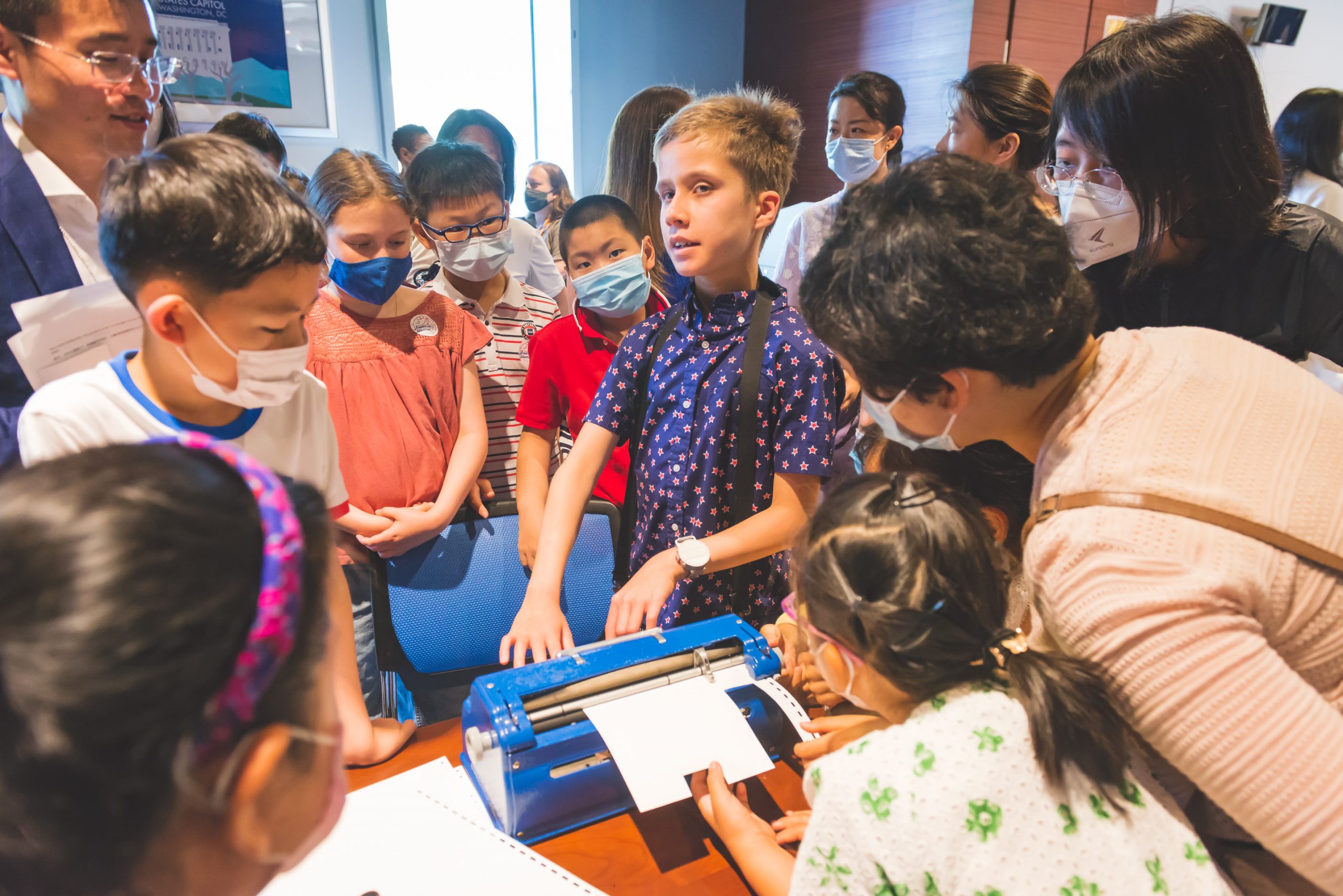As an 8th grader at the Western Academy of Beijing (WAB), my class often “sizes up” the incoming underclassmen at the beginning of each year. This year, there was a 6th grader who stood out from the rest – Noa, whom I noticed navigating the halls of Middle School with a white cane, carrying a laptop that looked quite different from the standard-issue Macbook most WAB students carry.

Noa uses his fingertips to read Braille on his BrailleNote Plus
Noa uses a cane because he’s been visually impaired since birth, however, with tools and a support teacher to assist when needed, he’s just like any other middle schooler at WAB.
We’ve eaten lunch together a few times, and each time he always has something fun to say. A few weeks ago, Noa participated in a literature festival hosted by the US Embassy in Beijing, reading two children’s books in braille. Interested, I sat down with him to find out what it’s like to be visually impaired.

Children gather to listen to Noa reading a braille storybook at the recent American Literature Festival
Noa and his family arrived in China less than two years ago, when he was in 5th grade. He says he enjoys WAB so far and is beginning to learn some Chinese. The school’s mission resonates with him as well. “I like WAB because we’re actually encouraged to make a difference, and I like the way WAB teaches us to do that.”
Noa is from the US but considers himself a citizen of the world. “I’d say that I’m really from everywhere,” he explains. “My dad’s French and my mom was born in the US, but she’s half Thai, half Latvian.”
Noa has been visually impaired since birth. “I am fully blind, except that I can see light versus darkness,” he says. However, that hasn’t stopped him from becoming a voracious reader, which he has accomplished using the braille system, a reading system he started learning at age 3. “[Braille] is basically a 6-dot system where any combination could make a number or letter,” Noa explains. “Some people would even call it code.”

Noa shows a crowd how to use a braille typewriter
Nowadays he uses the braille computer that he carries to school, which looks like a laptop, but instead of a standard QWERTY keyboard, has a special row of touch keys capable of presenting an ever-refreshing line of braille. This allows him to read anything from websites to Harry Potter.
Just like other laptops, his gets upgraded as new features are released. “I’ve had successive generations of a braille computer known as the BrailleNote (the BrailleNote, then the BrailleNote Touch, and most recently the BrailleNote Touch Plus),” he explains. “I use my computer like any visual computer – and the most recent versions include a touchscreen allowing my teachers to see my work at the lift of a lid.”

Instead of a screen, Noa’s laptop has a row of keys that can display letters in braille
Books in braille are easy to find – both digital and hard copy – through resources such as bookshare.org, a website designed for people with visual impairment and other barriers to reading, and the National Library Service for The Blind and Physically Handicapped, a division of the US-based Library of Congress. He’s also an audiobook listener, and WAB’s online library has plenty to choose from. “Graphic novels are probably the one genre of books that doesn’t translate well. “My computer would only display them as one ‘image’ after another.”
As for his favorites? “I mostly like reading mystery books such as Nancy Drew and The Hardy Boys.”

A huge group of kids gathers around Noa as he shows them how to type on a braille typewriter
In addition to understanding how he reads, I wondered how he plays sports, given that so many of them require vision.
He likes a sport called goalball – one of the official games of the summer Paralympics – which is suited to both blind and sighted players and involves getting the ball into the opponent’s goal while blindfolded.
Whether it’s sports, reading, or surfing the web, Noa’s life is more similar to his sighted classmates than you may think.
“It’s very inspiring to see Noa be optimistic, determined, and enjoy his school life despite the extra challenges he faces,” said one of Noa’s fellow WAB students, 8th grader Angelina.
KEEP READING: SENIA to the Rescue: Resources for Working With Differently Abled Children
Images: Uni You, Mike Wester




